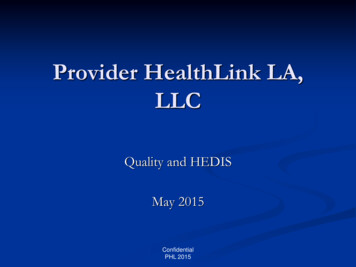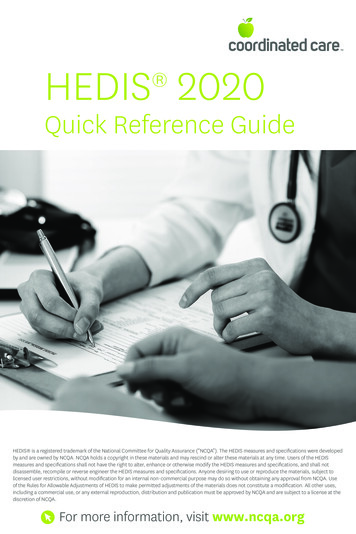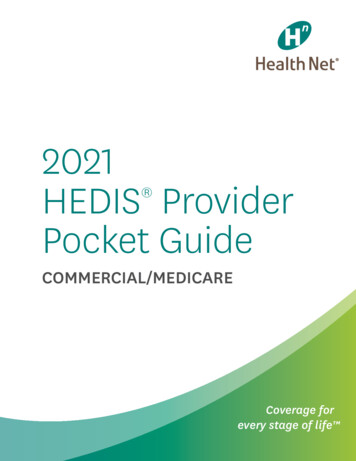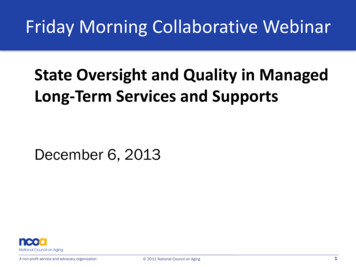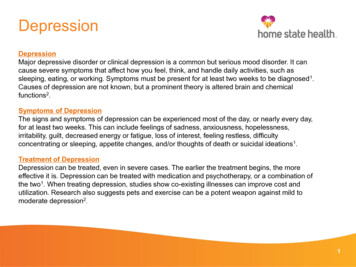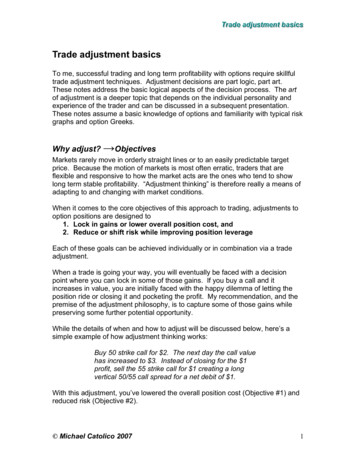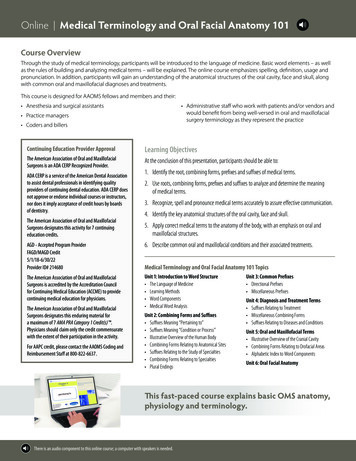
Transcription
Risk Adjustment Coding, Quality-HEDIS,and DocumentationProvider Education Training9/9/20192019
Objectives Discuss the Risk Adjustment methodology Understand how complete and accurate documentation and codingsupports good patient care Define Associated Quality and HEDIS measures Outline Tips for accurate and complete documentation Review Case Studies2Confidential and Proprietary Information
Frequently Used TermsBudget Neutrality – Normalization of risk scores to fit into pre-defined total budget for premium costs to cover care of allmembers assigned to all payers. Applies to Medicaid and Marketplace.Experience Period – Dates of service span used to calculate risk score (usually 12 months). Risk score is typicallycalculated 3 months or more after experience period ends to allow for some claims run-out.HEDIS – Set of performance measures in the managed care industry, developed and maintained by the NationalCommittee for Quality AssurancePayment Period – Period of time during which rates are effective. (In Medicare, known as payment year).Risk Gap – any suspected or known condition that has not been reported within the relevant experience period.RADV Audit – Risk Adjustment Data Validation Audit. This is an audit activity where CMS asks HPs to submit medicalrecords to support risk adjustment submissions. This will be yearly for Marketplace for all plans, yearly for Medicaid for asmall sample of plans, and varies by state for Medicaid.RAPS - Risk Adjustment Payment System is the encounter submission process of claims to CMS.Risk Model – Method by which risk score is calculated. Most risk models are based on grouping categories of similardiagnosis codes into categories, and assigning coefficients to each category.9/9/2019Confidential and Proprietary Information3
AcronymsACG- Adjusted Clinical GroupsHCPCS- Healthcare Common Procedure Coding SystemAWV- Annual Wellness VisitHCC- Hierarchical Condition CategoryCDPS- Chronic Illness & Disability Payment SystemHEDIS- Healthcare Effectiveness Data and Information SetCMS- Centers for Medicare and Medicaid ServicesHHS HCC- Health and Human Services HierarchicalCondition CategoryCPT- Common Procedure TerminologyDx- DiagnosisICD-10-CM- International Statistical Classification ofDiseases and related Health Problems, ClinicalModificationDxCG- Diagnostic Cost GroupIHA- In Home AssessmentEPSDT- Early and Periodic Screening, Diagnostic, andTreatmentPAF- Patient Assessment FormsDME- Durable Medical EquipmentRAF- Risk Adjustment FactorFFS- Fee for serviceConfidential and Proprietary Information44
What is Risk Adjustment?Risk Adjustment is the mechanism by which government programsadjust the revenue to health plans based on the health status of thecovered population(s).5Confidential and Proprietary Information
Benefits of Risk AdjustmentSufficient fundingMinimizeincentivesOptimizingQuality andEfficiencyDiseaseIdentifyingmanagementSpecial needs6Confidential and Proprietary Information
Risk Score CalculationPatient Assessment FormsMedical Record ReviewHospital ClaimsPharmacyClaimsOther Supplemental DataFilesDx fromSupp.DataSourceDx fromClaimsEligibilityProvider ClaimsIn-HomeAssessmentsNote: Not all claims are valid forrisk adjustment purposes.Risk Score9/9/2019Confidential and Proprietary Information7
Risk Adjustment Score MethodologyHigh Level Overview of ProcessStep 1: CMS assigns a benchmark payment rate (baseline demographics).Step 2: Members are assigned a risk adjustment score based on variousdiseases and conditions.Step 3: Benchmark rate is adjusted based on the risk factors and expectedcost to care for the member.Step 4: Risk adjustment factor scores are used to establish payment for thefollowing year. Health plan receives monthly payment based on thebenchmark rate and the risk adjustment score.Benchmark RateConfidential and Proprietary Information Risk Score MonthlyCapitatedPayment toHealth Plan8
Risk Adjustment ModelsMedicaidMedicareMarketplace199720042014 ACG, DxCG,CDPS Rx, etc(States decide) CMS-HCC (Part C)and Rx-HCC(Part D) Aggregated andBudget Neutral Individualized andAdditive Concurrent orProspectivePayments ProspectivePaymentsConfidential and Proprietary Information HHS-HCC(Federal), VariousState Models asapproved by HHS Aggregated andBudget Neutral ConcurrentPayments9
Risk Adjustment Models Disease groups contain major diseases and are broadly organized into body systems HCC (Hierarchical Condition Categories) Medicare HHS-HCC (Health & Human Service’s Hierarchical Condition Categories) Marketplace CDPS Rx (Chronic Illness and Disability Payment System) Medicaid Each HCC has an associated risk weight; each Category within the CDPS Rx Model has anassociated risk weight HCC’s are additive across different HCC’s but not within the same HCC HCC’s exhibit a trumping structure which is based on the severity of the documented disease.Credit is only provided for the most severe HCC within like HCC categories (DiseaseHierarchies) If a provider documented 5 different conditions all mapping to a different category from 8 to 12, theprovider would only receive credit for the most severe and highest weighted HCC within that DiseaseHierarchy, which in the above hierarchy is HCC 810Confidential and Proprietary Information
HCC Trumping StructureAn example of the HCC Hierarchy and Trumping Structure is shown: Column 1 indicates the HCC Category Column 2 provides the HCC Category Description Column 3 indicates which other HCC Categories are trumped bythat HCC Ex: HCC 8 trumps HCC 9, 10, 11, 129/9/2019Confidential and Proprietary Information11
Overview Example: MarketplaceMarketplace is a concurrent system and utilizes the HHS-HCC model. Marketplace has three age bands that are considered for riskadjustment: Adult, Child, Infant. There are five “metal levels” of insurance that can be purchased creating 15 possible risk scores for an HCC.The below table is an example that identifies the age and benefit level giving different scores for the HCC 161 Asthma:ModelPlatinumLevelGold LevelSilver LevelBronze usiness/Confidential and Proprietary Information12
Overview Example: MedicareMedicare uses the HCC method to calculate the risk score. This means there is a flat fixed rate for every member, and the score increasesdepending on the individual RAF score. Medicare’s rules are standard and apply to all plans who contract with Medicare. Medicare is aprospective system, meaning the payment is made based on a predetermined, fixed amount. Below is an example of how to documentaccurately in order to obtain and support a higher RAF score:Example 1Example 267 year-old male with type 2 diabetes with nocomplications, hypertension, and body mass index (BMI)of 37.267 year-old male with type 2 diabetes with diabeticpolyneuropathy, hypertension, morbid obesity with (BMI) of37.2, and status post-left below knee ionE11.9DM II nocomplications0E11.42DMII with ionZ68.37BMI 37.20E66.01 Z68.37Morbid obesitywith BMI 37.20.365Z89.512Status post-leftBKA0.779TotalConfidential and Proprietary Information0TotalRAF0.036801.180813
Overview Example: MedicaidMedicaid uses the Chronic Illness and Disability Payment System (CDPS), a diagnostic classification system. This method maps diagnosesto categories corresponding to major body systems or chronic diseases. There are various levels within categories, but only the mostsevere diagnosis mapping to the highest level within each category will count towards the risk score.Levels are: very low, low, medium, high, and very high within each category.Below is an example of how to document accurately in order to obtain and support a higher RAF score:Example 1Example 250 year-old female with type 2 diabetes and bipolar disorder50 year-old female with type 2 diabetes with diabeticpolyneuropathy, hypertension, and bipolar disorder in onRAFE11.9DM II nocomplications0.232E11.42DM II with diabeticpolyneuropathy0.232F31.9Bipolar Disorder0.618F31.7Bipolar disorder, .130Total1.302Total1.59914Confidential and Proprietary Information
Acuity and SpecificityBecause ICD-10-CM codes are used in risk adjustment, the documentation of acuity and specificity can be significant.Here are some examples of the increased specificity needs that are important to include in the documentation for risk sRenal failureObesityCKDHepatitis, acute hepatitis, unspecified viral hepatitis, alcoholic hepatitisNo HCCAcute hepatitis with hepatic failureHCC 27Alcoholic cirrhosisHCC 28Alcoholic hepatic failure without comaHCC 28Alcoholic hepatic failure with comaHCC 27Bronchitis not specified as acute or chronicNo HCCChronic bronchitisHCC 111Renal failureNo HCCAcute renal failureHCC 135ObesityNo HCCMorbid obesityHCC 22Unspecified, Stage 1, 2No HCCStage 3HCC 138Stage 4HCC 137Stage 5HCC 136Dependence on renal dialysisHCC 13415Confidential and Proprietary Information
Quality vs. Quantity Value-based compensationShifting from FFS model to pay-for-performance methodsPayers will reward value and care coordination-rather thanvolumeIncrease accountability for quality and total cost of care Already taking place in some states Category II codes required on claims for HEDIS16Confidential and Proprietary Information
Physician’s RoleRisk adjustment is an important process that allows the State and Federal government to gauge the acuity of a member population andconsequently allocate resources to the members health plan accordingly. This process ensures that members with the highest risk ofincurring medical expenses have the resources available to facilitate high quality care and meet their healthcare needs. Physician data (coding information submitted on physician claims) is critical for accurate risk adjustment. Physician claims data is the largest source of medical data for the risk adjustment models which help to determine how resourcesare allotted for care of the population. Specificity of diagnosis coding is substantiated by the medical record. Accurate coding helps to best reflect the cost of caring formembers/patients: It demonstrates the level of complexity for the patient encounters. It is vital to a healthy revenue cycle, and more important, to a healthy patient. Each progress note must (review the notes below for further description): Support what is coded and billed (ICD-10-CM, CPT, and HCPCS). “Stand alone” ensuring all information necessary to support medical necessity for services rendered on a given date ofservice are documented within each progress note for that date of service alone. Ensure all work for which the provider is given credit towards their medical decision making is clearly documentedwithin the progress note. Be complete and contain legible signature, credentials, and date.“Document for others as you would want them to document for you.”Confidential and Proprietary Information17
Medical Record Documentation Tips A condition only exists when it is documented Diagnoses do not carry over from visit to visit or year to year A condition can be coded and reported as many times as patient receives care and treatment for the condition Do not code for conditions that were previously treated and no longer exist Conditions can be coded when documentation states condition is being monitored and treated by a specialist “Patient on Coumadin for atrial fibrillation; followed by Dr. Hill” Co-existing conditions can be coded when documentation states that the condition affects the care, treatment, ormanagement of the patient. “Autistic patient comes in for chronic constipation” Document and code status conditions at least once a year Examples: Transplant status, amputation status, dialysis status, chemotherapy status, artificial openingstatus/maintenance Do not code unconfirmed diagnoses Examples: Probable, possible, suspected, working diagnosis Do not use arrows or symbols alone to indicate diagnosis cholesterol hypertension Be sure diagnosis code(s) billed are consistent with medical record documentation Example: Assessment & Plan documentation lists I10 only with no description. Cannot list ICD-10 Diagnosis code alone. Must document hypertension somewhere in the medical record.18Confidential and Proprietary Information
Commonly overlooked diagnosesDescriptionMajor organ transplantICD-10 code(s)Z94.- Transplanted organ and tissue statusArtificial openingZ93.- Artificial opening statusAmputationRenal dialysisZ89.4- - Acquired absence of foot and/or toe(s)Z89.5- - Acquired absence of leg below kneeE66.- Overweight and obesityZ68.4- BMI 40 or greaterZ99.2 Dependence on renal dialysisParaplegiaQuadriplegiaG82.2- ParaplegiaG82.5- QuadriplegiaHIV statusB20 HIV disease, symptomaticMyocardial InfarctionI25.2 Old or healed myocardial infarctionObesity19Confidential and Proprietary Information
Diagnosis Coding Tips20Confidential and Proprietary Information
Diagnosis Coding TipsExample of a Risk Adjustment Coding Tip for Providers on HSH website21Confidential and Proprietary Information
MEATProviders must accurately document the patient’s diagnoses for each visit (encounter).Utilizing the MEAT acronym is a great tool to use when documenting current and chronicconditions. Any condition that is supported by monitoring, evaluating, assessing or treatingcan be coded. The following slide has more definitive examples.MonitoringEvaluationAssessmentTreatment Medical record documentation must haveMEAT documented for each diagnosis A simple list of diagnoses is not acceptable.Chronic diseases treated on an ongoing basis may becoded and reported as many times as the patientsreceive treatment and care for the condition(s).The MandateCode all documented conditions that coexist at thetime of the encounter/visit, and require or affectpatient care, treatment, or management.Outpatient ines fy2018 final.pdf Section IV. I. & J.Confidential and Proprietary Information22
MEAT (cont’d)MEATSupportDisease Example Documentation ExamplesMonitor CHFStable. Will continue same dose of Lasixand ACE inhibitorDJD, hipPain controlledHyperlipidemiaLipid profile orderedEvaluateAssess/AddressTreatSymptomsDisease progression/regressionOrdering of testsReferencing labs/other tests Test resultsMedication effectivenessResponse to treatmentPhysical exam findingsType 2 DMBlood Sugar log and A1c resultsreviewed with the patientDecubitus ulcerRelay wound measurement in exam Discussion, review recordsCounselingAcknowledgingDocumenting status/level of conditionPeripheral neuropathyDecreased sensation of bilateral legextremities by monofilament testUlcerative colitisManaged by Dr. Smith Prescribing/continuation of medicationsSurgical/other therapeutic interventionsReferral to specialist fortreatment/consultationPlan for management of conditionTobacco abuseAdvised on risks; smoking cessationcounselingGERDNo complaints. Symptoms controlled oncurrent meds Confidential and Proprietary Information23
Specificity Documentation should be as specific as possible. Specific documentation and coding guidelines are mandated by HIPAA.If you mean .Don’t say .Chronic obstructive asthma withacute exacerbationCOPDHypertensive heart disease withheart failureHeart failure/HypertensionLung cancer with metastasis to liverLung cancerLiver cancerAlcohol DependenceAlcohol abuseDominant side hemiplegia due to CVA History of CVA/ Hemiplegia24Confidential and Proprietary Information
Past Medical History Medical history is the information about the patient’s health before thepresenting complaint Includes experiences with illnesses, operations, injuries and treatments Some conditions do not go away; however, coding from past medical historywithout current support for the condition is not acceptable Beware that some EMR software “auto-populates” all conditions previouslycoded for that patient Do not “copy and paste” without updating/editing the conditions Why is this condition a problem?Was it coded correctly?Is the condition still active?When did the condition last occur?Who is treating the condition?25Confidential and Proprietary Information
Current vs. History of Be sure to use proper tense when documenting conditions. Frequent documentation errors: Coding a past condition as active Coding a history of when condition is still activeIncorrect DocumentationCorrect DocumentationHistory of CHF-meds LasixCompensated CHF-stable on LasixBreast cancer-status post RmastectomyHistory of breast cancer-status post RmastectomyHistory of Asthma, meds SymbicortAsthma-stable on SymbicortCVA 2007-currently stableHistory of CVA 2007-no residual deficits26Confidential and Proprietary Information
Risk Adjustment & Quality27Confidential and Proprietary Information
Annual Wellness Visit (AWV) andEarly & Periodic Screening, Diagnostic, and Treatment (EPSDT)Perfect opportunity to capture: Quality AWV (Annual Wellness Visit)EPSDT (Early and Periodic Screening, Diagnostic and Treatment)BMIMedication ReviewVaccinationsLead ScreeningPreventive Screenings (Breast, Colon, etc.) Risk Adjustment (Chronic Conditions) Address historical conditionsStatus conditionsClean up Problem List28Confidential and Proprietary Information
Annual Wellness Visit & EPSDT29Confidential and Proprietary Information
Annual Wellness VisitsChecklist Review and address all present conditions. Verify all conditions, medications, DME, injections/infusions Rule out any suspected conditions or address themGeneral exam diagnosis code .Definition .Example .Z00.01 (adult) or Z00.121 (childincludes 18-20 years)“with abnormal findings”. Use with anyabnormality that is present at time of routineexamination. Report supplemental diagnosiscodes, such as chronic conditions that had tobe addressed, in addition to the well exam.“Patient has mild depressed bipolar Idisorder, without psychotic features.Increased LAMICTAL to 100 mg daily.Z00.00 (adult) or Z00.129 (childincludes 18-20 years)“with normal findings”. Use for chronicconditions that are stable or improving.Report the chronic condition in addition tothe well exam.“GERD is stable, no longer on medication.Follow up for next well visit or earlier ifneeded.”30Confidential and Proprietary Information
Risk Adjustment/Abnormal Findings31Confidential and Proprietary Information
Risk Adjustment & HEDISCommon Reported Diseases32Confidential and Proprietary Information
HEDIS and EPSDTWhat is HEDIS (Healthcare Effectiveness Data and Information Set)?It is a data and information set that captures performance measures in the managed care industry, developed and maintained by the National Committee forQuality Assurance (NCQA) Includes 90 measures across 6 domains of care-Effectiveness of Care-Access /Availability of Care-Experience of Care-Utilization and Risk Adjusted Utilization-Health Plan Descriptive Information-Measures Collected Using Electronic Clinical Data SystemsWhat is EPSDT (Early and Periodic Screening, Diagnostic, and Treatment)?It is a Medicaid (State) benefit that captures comprehensive and preventive health care services on members under age 21 Includes 5 main elements of the program-Assess and identify problems early, starting at birth-Identifies risks and performs diagnostic tests-Check children’s health at periodic, age-appropriateand assessments: lead screeningscomprehensive well-child visits-Assists with treatment of identified conditions-Provide screenings that include: vision, dental, physical,developmental, mental, labs, etc.How does HEDIS And EPSDT correlate?Many of the measures overlap, such as lead screening, immunizations, weight assessment, testing children with pharyngitis, depression screening, ADHDmedication, etc.Utilizing the EPSDT components and accurately documenting/coding diagnoses and procedures assists with capturing data for HEDIS measures.Confidential and Proprietary Information33
RA- Malignant Neoplasm Coding TipsTIPS: Current “Active”Malignancy “History of” vs “InRemission” Documentation Tips9/9/2019Confidential and Proprietary InformationICD-10 Mapping & EducationDocumentation must show clear presence of current disease.Active includes that the malignancy was excised but patientis still undergoing treatment directed to that site. Primarymalignancy codes should be used until treatment iscomplete.oPhysician/patient chose not to treatoEvidence of current/ongoing treatmentoChemotherapyoRadiation therapyoSuppressive therapy if documentation does not show clear evidence of activedisease or treatment, malignancy is considered a “historyof” for coding purposes (Z85.--). Evidence includes:o Definitive surgical treatmento Completion of treatment regimeno Follow-up/surveillance for recurrence some neoplasms can be “in remission”, such as leukemiaThe following language supports actively monitoring [any]condition and must be documented by the provider. In thedocumentation, mention oMedications reviewed and are current.oIf patient is seeing a specialist.oWhether there has been any or no recent onset of thedisease/condition.EXAMPLESCurrent CancerColonBreastCervicalC18.0-C18.9, C19-C20,C21.2, C21.8, C78.5C50.011-C50.929, C79.81C53.0-C53.9, C79.82“History of”PersonalMastectomyCervix, absenceZ85.– (code range)Z90.13Q51.5, Z90.710, Z90.712“In Remission”LeukemiaC95.01Multiple Myeloma C90.0134
HEDIS: Cancer ScreeningsColorectal ScreeningCervical ScreeningMeasure evaluates thepercentage of members ages50-75 who had at least one ofthe following screenings.Measure evaluates thepercentage of women ages 2164 who were screened forcervical cancer.Exempt from measure Total colectomy History of colon cancerExempt from measure Women who have hadhysterectomy without a cervixBreast ScreeningMeasure evaluates thepercentage of women age 50-74who had a mammogram at leastonce in the past 27 months.Exempt from measure Women who have had bilateralmastectomy Diagnostic screenings9/9/2019Confidential and Proprietary Information35
RA- Diabetes Coding TipsTIPS: ICD-10-CMICD-10 Mapping & Education Documentation should specifyoo Secondary diabetes(E08- series)Code first any underlying conditions, code second the type of diabetes:oCongenital rubella (P35.0)o Cushing’s Syndrome (E24.-)oCystic fibrosis (E84.-)o Malignant neoplasm (C00-C96)oMalnutrition (E40-E46)o Diseases of the pancreas (K85.-, K86.-) Cause and effect relationship E08 – E13 code series (Diabetes)O24 code series(Diabetes in Pregnancy)Type of DM (Type 1, Type 2, Other)Complication/manifestation affecting body systemExample: Secondary DM due to pancreatic malignancy (C25.9 E08.9)State any relationship between DM and another condition such as:oDiabetic comao Gastroparesis secondary to diabetesoNeuropathy due to diabetes o Foot ulcer associated with diabetesExample: Diabetic retinopathy with macular edema (E11.311)*Note: When type of diabetes is not documented, default to category E11 (type 2). Use additional code Controlling Diabetes Avoid terms such as “history of” 9/9/2019Confidential and Proprietary Information to identify:oSite of any ulcers (L97.1-L97.9, L89.41-L98.49)oStage of chronic kidney disease (N18.1-N18.6)oGlaucoma (H40-H42) be sure to add:oLong-term insulin use (Z79.4)oOral antidiabetic drugs (Z79.84) or Oral hypoglycemic drugs (Z79.84) if patient is still being monitored for the condition.o Incorrect wording: Patient has history of diabetes.o Correct wording: Patient has Type 2 DM with ketoacidosis.36
HEDIS: DiabetesComprehensive Diabetes Care (CDC)Measure demonstrates the percentage ofmembers ages 18-75 with diabetes (types 1 & 2)who were compliant with A1c testing, A1c control,Eye exam screenings, Blood Pressure control andNephropathy.Statin Therapy for Patients with DiabetesMeasure demonstrates the percentage ofmembers ages 40-75 with diabetes who do nothave clinical atherosclerotic cardiovasculardisease (ASCVD) who received statin therapy andmaintained statin adherence.Type 1 Type 2 OtherDescriptionE10.1- E11.1- E13.1-DM with ketoacidosisE10.2- E11.2- E13.2-DM w/kidney complicationsE10.3- E11.3- E13.3-DM w/ophthalmic complicationsE10.4- E11.4- E13.4-DM w/neurological complicationsE10.5- E11.5- E13.5-DM w/circulatory complicationsE10.6- E11.6- E13.6-DM w/other specified complicationsE10.8- E11.8- E13.8-DM w/other specified complicationsE10.9- E11.9- E13.9-DM w/o complicationsBe sure to add Z79.4, long-term insulin use if appropriate9/9/2019Confidential and Proprietary Information37
HEDIS: CDC - Nephropathy ScreeningNephropathy ScreeningStaging Chronic Kidney Disease (CKD)Measure demonstrates the percentage ofmembers ages 18-75 with diabetes(types 1 & 2) who had a urine protein testperformed at least once per year, treatedfor nephropathy (on ACE/ARB), hasevidence of End Stage Renal Disease(ESRD), stage 4 CKD, a history of akidney transplant or is being seen by anephrologist.Note: All stages need to be chronic, not a one-time event.SeverityGFR* ValueICD-10CodesStage INormalGFR 90 ml/min/1.73 m2 with kidneydamage*N18.1Stage IIMildGFR 60-89 ml/min/1.73 m2 with kidneydamage*N18.2Stage IIIModerateGFR 30-59 ml/min/1.73 m2N18.3Stage IVSevereGFR 15-29 ml/min/1.73 m2N18.4Kidney FailureGFR 15 ml/min/1.73 m2N18.5StageStage VGFR 15 ml/min/1.73ESRDCKD Unsp.CRD, CRF NOS orCRI**Requiring chronic dialysis or transplantation(End stage renal disease)N18.6Chronic Kidney Disease, unspecifiedN18.9*GFR- Glomerular filtration rate**CRD- Chronic renal disease, CRF- Chronic renal failure, CRI- Chronic renal insufficiency, NOS- not otherwisespecified9/9/2019Confidential and Proprietary Information38
RA- Hypertension Coding TipsTIPS: ICD-10-CM Hypertension (HTN) andChronic Kidney Disease(CKD) HTN and Heart DiseaseICD-10 Mapping & EducationI10 - I16 (Hypertensive Diseases)ooPresumed cause and effect relationship when patient has both HTN and CKD.Use additional code to identify the stage of the chronic kidney diseaseoCode HTN -I12.0 CKD- N18.5, N18.6 (Stage 5, ESRD) orHTN -I12.9 CKD -N18.1-N18.4, N18.9 (Stage 1-4, CKD unspecified)oWhen ESRD (N18.6) is coded, assign:o Z99.2 for any “dialysis status”o Z91.15 for “noncompliance with renal dialysis”ooNo presumed linkage between HTN and Heart disease.Causal relationship must be stated. Examples:o Due to hypertensiono Implied (hypertensive)If heart failure is recent, assign additional code from category I50 to identify thetype of heart failure.o Other HTN Coding Tips9/9/2019Confidential and Proprietary InformationoDo not use symbols to express hypertension.blood pressure hypertensionUse additional code to identify:o Exposure to environmental tobacco smoke (Z77.22)o Exposure to tobacco smoke in the perinatal period (P96.81)o History of tobacco dependence (Z87.891)o Occupational exposure to environmental tobacco smoke (Z57.31)o Tobacco dependence (F17.-) or Tobacco use (Z72.0)39
HEDIS: Controlling High Blood PressureControlling High Blood Pressure (CBP)Measure demonstrates the percentage ofmembers ages 18-85 with a diagnosis ofhypertension and whose blood pressure wasadequately controlled ( 140/90) during themeasurement year.Statin therapy for Patients withCardiovascular Disease (SPC)Measure demonstrates the percentage ofmembers ages 21-75 (males) and 40-75(females) who were identified as having clinicalatherosclerotic cardiovascular disease(ASCVD) who received statin therapy andmaintained statin adherence.Specifications for Controlling High Blood Pressure Must be the most recent blood pressure readingtaken during the measurement year. Blood pressure reading must occur on or afterthe date of the second diagnosis ofhypertension. When there are multiple blood pressurereadings on the same date of service, thelowest systolic and lowest diastolic should beused as the representative blood pressure.DescriptionCPT II Category CodesDiastolic 80-893079FDiastolic Greater than equalto 903080FDiastolic Less than 803078FSystolic Greater than equalto 1403077FSystolic Less than 1403074F, 3075F40Confidential and Proprietary Information
RA- Depression Coding TipsTIPS: ICD-10-CMICD-10 Mapping & EducationF32.0 – F33.9 (Major depressive disorder) Attempt for more specificity Avoid broad terms and unspecified codes such as “Depression”, F32.9o Document depression in detail including severity and episode.o It leads to precise coding and a better awareness about the disease andthe population it affects. In the documentation use termsthat specify oo Depression Screening Toolo Refilling medicationSeverity (mild, moderate, severe)Episodes (single, recurrent, or in remission)Mental Health America offers a convenient questionnaire making it easyto obtain specific diagnosis codes.o Note all disclaimers on the website.o Visit creen/patienthealth.Don’t forget to verify the condition and list the diagnosis in the Assessment &Plan.Depression Screening Tool: The Patient Health Questionnaire (PHQ-9) is a 9-question instrument given to patients in a primary care setting to screen forthe presence and severity of depression. The results of the PHQ-9 may be used to assist providers in making a depression diagnosis, includingcorresponding severity. An acceptable site to find the questionnaire can be found here: 1/f/201412/PHQ9 English.pdf9/9/2019Confidential and Proprietary Information41
HEDIS: DepressionAntidepressant MedicationManagementMeasure evaluates the percentage of
Acuity and Specificity Confidential and Proprietary Information Because ICD-10-CM codes are used in risk adjustment, the documentation of acuity and specificity can be significant. Here are some examples of the increased specificity needs that are important to include in the documentation for risk adjustment: Disease Specificity HCC
